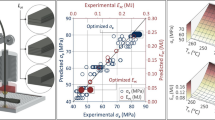Abstract
Time–temperature–stress superposition principle (TTSSP) was widely applied in studies of viscoelastic properties of materials. It involves shifting curves at various conditions to construct master curves. To extend the application of this principle, a temperature–stress hybrid shift factor and a modified Williams–Landel–Ferry (WLF) equation that incorporated variables of stress and temperature for the shift factor fitting were studied. A wood–plastic composite (WPC) was selected as the test subject to conduct a series of short-term creep tests. The results indicate that the WPC were rheologically simple materials and merely a horizontal shift was needed for the time–temperature superposition, whereas vertical shifting would be needed for time–stress superposition. The shift factor was independent of the stress for horizontal shifts in time–temperature superposition. In addition, the temperature- and stress-shift factors used to construct master curves were well fitted with the WLF equation. Furthermore, the parameters of the modified WLF equation were also successfully calibrated. The application of this method and equation can be extended to curve shifting that involves the effects of both temperature and stress simultaneously.







Similar content being viewed by others
References
Barpanda, D., Mantena, P.R.: Effect of hybridization on the creep and stress relaxation characteristics of pultruded composites. J. Reinf. Plast. Compos. 17(3), 234–249 (1998)
Chang, F.-C., Lam, F., Englund, K.R.: Feasibility of using mountain pine beetle attacked wood to produce wood-plastic composites. Wood Fiber Sci. 42(3), 388–397 (2010)
Cowie, J.M.G.: Polymers: Chemistry and Physics of Modern Materials. Intext Educational Publishers, New York (1973)
Darlington, M.W., Turner, S.: Creep of thermoplastics. In: Pomeroy, C.D. (ed.) Creep of Engineering Materials. Journal of Strain Analysis Monograph, pp. 197–213. Mechanical Engineering Publication Ltd., London (1978)
Dastoorian, F., Tajvidi, M., Ebrahimi, G.: Evaluation of time dependent behavior of a wood flour/high density polyethylene composite. J. Reinf. Plast. Compos. 29(1), 132–143 (2010)
Doolittle, A.K.: Studies in Newtonian flow. II. The dependence of the viscosity of liquids on free-space. J. Appl. Phys. 22(12), 1471–1475 (1951)
Ferry, J.D.: Viscoelastic Properties of Polymers, 3rd edn. Wiley, New York (1980)
Luo, W., Yang, T., An, Q.: Time–temperature–stress equivalence and its application to nonlinear viscoelastic materials. Acta Mech. Solida Sin. 14(3), 195–199 (2001)
Miyase, A., Chen, A.W.-L., Geil, P.H., Wang, S.S.: Anelastic deformation of a thermoplastic-matrix fiber composite at elevated temperature; part II: time–temperature dependent matrix behavior. J. Compos. Mater. 27(9), 886–907 (1993)
Nicholson, L.M., Gates, T.S.: The influence of cross-link density on the creep compliance of an advanced polyimide. J. Thermoplast. Compos. Mater. 14, 477–488 (2001)
Nkiwane, L., Mukhopadhyay, S.K.: Mathematical representation of creep for high-temperature performance of nylon 6.6 tire materials. J. Appl. Polym. Sci. 72, 1505–1511 (1999)
Pooler, D.J., Smith, L.V.: Nonlinear viscoelastic response of a wood–plastic composite including temperature effects. J. Thermoplast. Compos. Mater. 17, 427–445 (2004)
Sain, M.M., Balatinecz, J., Law, S.: Creep fatigue in engineered wood fibre and plastic composition. J. Appl. Polym. Sci. 77, 260–268 (2000)
Smith, P.S., Wolcott, M.P.: Opportunities for wood/natural fiber–plastic composites in residential and industrial applications. For. Prod. J. 56(3), 4–11 (2006)
Tajvidi, M., Falk, R.H., Hermanson, J.C.: Time–temperature superposition principle applied to a kenaf-fiber/high-density polyethylene composite. J. Appl. Polym. Sci. 97, 1995–2004 (2005)
Urzhumtsev, Yu.S., Maksimov, R.D.: Time-stress superposition in nonlinear viscoelasticity. Mekhanika Polim. 4(2), 379–381 (1968)
Acknowledgements
Authors acknowledge Forestry Innovation Investment Ltd., British Columbia, Canada, for providing financial support to this study.
Author information
Authors and Affiliations
Corresponding author
Rights and permissions
About this article
Cite this article
Chang, FC., Lam, F. & Kadla, J.F. Application of time–temperature–stress superposition on creep of wood–plastic composites. Mech Time-Depend Mater 17, 427–437 (2013). https://doi.org/10.1007/s11043-012-9194-9
Received:
Accepted:
Published:
Issue Date:
DOI: https://doi.org/10.1007/s11043-012-9194-9




